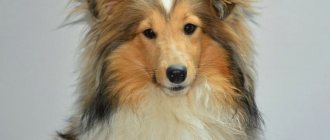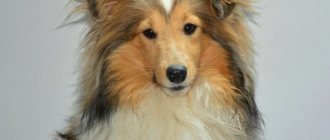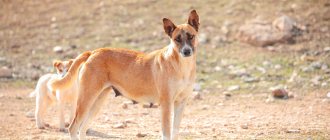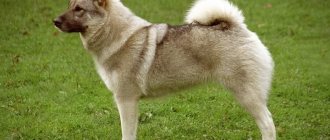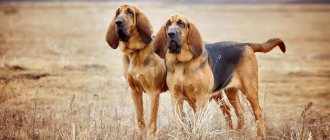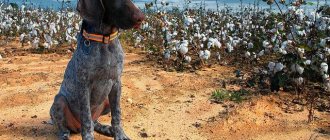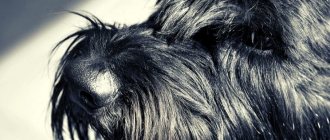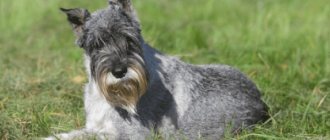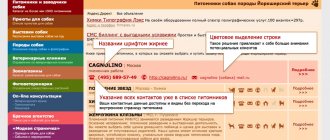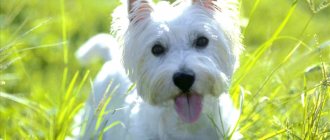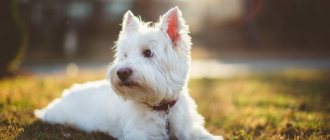Description of the Miniature Schnauzer breed
Popularity 15th among 263 dog breeds
Lifespan:
13-15 years old
Breed group:
Service
Height:
45-50 cm
Country of origin:
Germany
Average price:
20-130 thousand rubles
Weight:
17-25 kg
Latest articles Cat health
Rabies vaccination for cats: choice of vaccine, necessity, schedule 01/22/2022 15 0 0
Selection and adaptation
TOP 20 best cat breeds for families with children 01/22/2022 27 0 0
Key facts
If you literally translate the German name of the breed, you get the funny combination “medium-sized muzzle.” This is true - Mittels are medium-sized representatives, Miniatures are small, and Huge Riesens are large schnauzers.
The characteristics of the Schnauzer breed emphasize that the dogs have good leadership abilities and from time to time check their owner to see if he is losing ground. That is why the owner will sometimes have to communicate with his pet quite strictly.
Despite a highly developed sense of distrust of strangers, in the circle of their family, Mittels behave very affectionately and emotionally, evenly distributing their feelings among all members, but especially highlighting children.
The description of the Miniature Schnauzer breed says that the dogs require serious physical activity due to their excessive activity. The ideal would be a combination of physical and mental exercises where the dog will have to think.
The upbringing process can sometimes stall, seemingly out of the blue. Actually this is not true. It’s just that the cunning dog decided to think about whether he needed all this.
This is a working breed that has proven itself well both in guard duty and in participation in search activities, due to its keen sense of smell.
Animals get along well with other dogs and cats living with them in the same family, but rodents and birds can be strangled due to a strong hunting instinct.
The health and life expectancy of the Miniature Schnauzer are not bad; they can be called a breed that is not too troublesome in this regard.
Kinds
There are 3 types of dogs from the Schnauzer group: Riesen, Mittel and Zwerg. The dog we are considering is medium in size. He is 20 cm shorter than his closest relative, the Giant Schnauzer.
In terms of character, these animals are practically no different, but in terms of coat color and exterior features - yes. Speaking about the color of the breed, we need to highlight 2 possible options:
- Gray with salt. The most common option. The name is unusual, however, it perfectly describes the appearance of the dog. Various gray color saturation options are allowed.
- Pure black. Typically, Miniature Schnauzer puppies are born reddish or grayish, gradually darkening. These dogs also have a black undercoat. If adult individuals have grayish hairs, it is recommended to pluck them out with tweezers.
Sometimes dark-colored dogs have light markings on their chest and head. Their presence is extremely undesirable.
History of the origin of the Miniature Schnauzer
The exact time of formation of this breed is unknown. It is noted that on the territory of modern Germany several thousand years ago there were certain turf dogs, which, judging by various sources, resembled schnauzers in the size of the body and the shape of the skull bones.
As an independent breed, the Schnauzer developed quite late. It is believed that these dogs were the result of breeding work that included breeds such as the Keeshond, Wirehaired Pinscher and German Poodle. The animals served as rat catchers, protecting the stables from rodents.
The Mittels entered the world stage in 1879. It was then that at the Hanover exhibition the first place was awarded to the average schnauzer. After this victory, many breeders turned their attention to this breed and began to actively develop it. Literally a year later, in 1880, the first official breed standard was registered, and in 1921 a breed club was formed.
The dogs came to America at the beginning of the twentieth century, where they were classified as terriers. In the 40s they were formed into a separate working group. But in Russia, interest in this breed awoke quite late. The first litter was received in 1979.
Kennels where you can buy a puppy
You need to choose a nursery based on reviews from previous clients and awards given to the students. There are several official clubs in Russia that have proven themselves well among dog breeders:
- “NiM” St. Petersburg – https://nim-schnauzer3.narod.ru/;
- “Rus Rastr” Moscow – https://www.rus-rastr.com/;
- “Nettle Great” Nizhny Novgorod – https://nettlgreitkennel.jimdo.com/;
- "Alpen Travel" St. Petersburg - https://at812.narod.ru/Index.htm;
- “From Barbatsutsy” Moscow – https://otbarbatsutsy.ru/ru/mittelshnaucer.html;
- “Feble” Nizhny Novgorod – https://www.schnauzer-nnov.ru/?page_id=10.
The Miniature Schnauzer, like its closest relatives, is an ideal companion and assistant in all household matters. It will entertain the children, lift their spirits, and protect the house. But in order to receive boundless devotion and love, it must be given to the dog in the same amount.
4 / 5 ( 2 voices)
Appearance of the Miniature Schnauzer
General impression
Representatives of this breed are distinguished by wide, strong bones, a square skull and coarse hair. The dogs are quite stocky; tall-legged representatives are not found. From the photo, it is a little difficult to distinguish miniature schnauzers from their smaller relatives - miniature schnauzers.
Head
The bones of the skull are strong, massive, and it itself has an oblong shape. The occipital protuberance is visible to the naked eye. The transition from forehead to muzzle is sharp. The forehead is flat, there are no wrinkles. The muzzle is wedge-shaped with a straight line at the back of the nose.
The nose is large, only black is allowed. The lips are black, close tightly together and adhere to the teeth. The jaws are strong, large, and have a standard scissor bite. Mittels have a well-developed dental system with 42 large teeth.
The eyes are dark, oval-shaped, and deep-set. The ears are triangular in shape, hang on cartilage, the inner edges touch the cheekbone, docking is allowed.
Neck
The neck of representatives of this breed is strong, has well-developed muscles and is of medium length. A smooth, neat transition to the withers is noticeable.
Torso
The body is squat, the format is squared. The topline is slightly sloping from the height of the withers to the croup, forming a slight slope. The withers are the highest zone. The back is strong, short, muscular. The chest is oval, deep set.
The lowest point of the chest should be at the level of the dog's elbows. The lower back is muscular, shortened. Dome shape is not allowed. The croup is rounded, smoothly extending to the base of the tail. The belly line is smooth and curved.
Forelegs
The paws are strong, straight, when viewed from the front, completely parallel to each other, the muscles are well defined. The setting is wide enough. The scapula bones are adjacent to the body. The angle is 95-105 degrees. Pasterns are strong, stable, slightly springy.
Hind limbs
When viewed from behind, the paws are parallel to each other and have neither a narrow nor a wide set. Knees point straight. When the animal is in the breed stance, they are not expressed. The lower legs are sinewy, strong, elastic. The hock joints have significantly pronounced angles, especially noticeable when standing. Fingers are small. The pads and claws are black.
Tail
The natural tail has a saber or crescent shape. The hare's position, when he lies flat on his back towards the head, is considered a significant fault. Docking at the level of 2-3 caudal vertebrae is not prohibited.
Movements
Schnauzers, despite their square format, have natural beautiful, one might even say, refined movements. The step is free, sweeping, active, there is no stiffness. Paw pushes are elastic, springy.
Wool
These animals belong to the category of wire-haired dogs. The coat is rough to the touch, adheres tightly to the thick undercoat, and lacks elasticity. The length is average. The hair covering the head is shorter than that on the body. The beard and eyebrows are also tough. Mittels require regular trimming, which consists of plucking out old hair and helps the dog grow new hair. This is due to the fact that pets completely lack independent molting. Shearing is prohibited; it spoils the quality of the wool, making it thinner.
Color
There are only two acceptable colors of the Schnauzer according to the breed standard:
- Classic black, when both the coat and undercoat have the same uniform shade. In this case, the puppies can be brown or dark gray, and after a while they change color and become black;
- “Pepper and salt” is cultivated and has several shades – from light silver to dark steel. In this case, the dog should have a black darkened mask that favorably emphasizes the shape of the head.
Size
The height of miniature schnauzers, both males and females, at the withers should be no lower than 40 cm and not exceed 45 cm. Optimal height is 42-43 cm. The weight of the Miniature Schnauzer ranges from 14 to 20 kg.
Any deviation from the official breed standard may reduce the show score. This also applies to the size of the Miniature Schnauzer.
Reproduction and lifespan
The Miniature Schnauzer is an active and strong dog that lives from 14 to 16 years. The lifespan of bitches who give birth to puppies annually is shorter. Their body loses strength faster and therefore ages prematurely.
Experts advise pairing mature females with males only after they reach at least 2 years of age. Breeding younger individuals is contraindicated. They will probably not be able to conceive healthy, full-fledged offspring.
It is also necessary to take into account that mating of non-purebred Schnauzers is unacceptable for a professional breeder. He must select dogs that fully comply with the standard and do not have any deviations from it.
Mating does not occur from the first days of the bitch's heat, but approximately 4-5. This way the chances of conceiving puppies are higher. Presumably a pregnant female should be surrounded by care. You should not force her to walk for a long time and, especially, to perform various tricks. She should get more rest.
Character of the Miniature Schnauzer
We can say with confidence that absolutely all animals of this breed are multidisciplinary. They are excellent companions, working dogs, service dogs, and are actively used in search and rescue teams. In addition, the average schnauzer is an excellent watchman who guards the home territory entrusted to him, trying not to let strangers into it.
These are smart, cunning, dexterous and very smart dogs. They are happy to learn commands with their owner, performing them almost the first time. Constant learning is not required - the dog, having completed the exercise once, can easily repeat it at any time.
This is a very active breed, not only in terms of physical work, but also in expressing feelings. The pet always happily greets all family members, attracts attention, invites you to play and run for a walk. Schnauzers love children and patiently tolerate various pranks in their direction. But they won’t tolerate rude behavior, although they won’t snap and growl at the kids, but will simply go out of sight.
They treat strangers in the house with suspicion, but if they see that the owner is actively communicating with them, they may come up to meet them. But even after this they will not let you out of sight, trying to keep everything under control. The character of the Miniature Schnauzer makes it a unique dog, capable of displaying the widest range of feelings and emotions.
Man and dog
Guarding is the best activity for Miniature Schnauzers. They are natural watchdogs, although canine organizations do not require working tests for breeding or participation in animal husbandry activities.
Thanks to their intelligence and restraint, mittels can simply be companions . Standard schnauzers are practically never seen during hunting.
They also need an outlet for energy , so it is recommended for people with an active lifestyle to have them. In a home with children , they will turn from a formidable guard into a dear friend, and cats will be considered the property of the owner and protected along with other property, without encroaching on their lives.
The life of their ancestors in the stables affects the attitude of the mittels towards horses . They are adapted to walk together with these animals.
Miniature Schnauzers are physically and psychologically resilient, suitable for jogging next to a skier or cyclist. They can be taken on day hikes .
Education and training
It is recommended to start learning the basics of raising and training a Miniature Schnauzer a couple of weeks after the puppy has moved to its new home and has become accustomed to it. The exercises are performed calmly and methodically, with multiple daily repetitions.
The first to learn are the basic commands: “Sit”, “Lie down”, “No/Fu”, “Place”. After the baby has been vaccinated and quarantined, you can try the commands “Near” and “Come” on walks.
If you plan to attend exhibitions, the dog must be able to show its teeth. In this case, it is necessary to start socializing the dog as early as possible so that in the future it will not be afraid of large and noisy places where people and dogs gather. Try to teach your pet to perceive the hands of strangers as adequately as possible, since judges often examine animals in detail.
Toilet training of the little mittel begins as early as possible. Regardless of the season - winter, spring, summer or autumn - the owner must take the baby for a walk every day at a certain time. You should start with 4-6 times a day, gradually moving to two or three walks.
If the puppy shows interest in shoes and chews furniture, it is necessary to strictly but calmly prohibit him from doing this. Physical punishment is unacceptable.
It is recommended that you take your pet through a general training course, during which competent dog handlers will tell and advise dog owners how to raise a puppy and how to find an approach to their pet, taking into account the breed’s temperamental characteristics.
Looking for a Miniature Schnauzer? Find your pet from 1 offer As a gift
Where to buy and price
Nurseries engaged in breeding miniature schnauzers are represented in large numbers in Russia due to the popularity of the breed. Many large cities have their own nurseries, so potential owners do not have to go somewhere to get a puppy. Among them are:
- Dar'Ilion (Moscow);
- Fortuna Minion (Saratov);
- Don Delaro (Rostov-on-Don);
- Art Platinum (Nizhny Novgorod).
The price of a dog from professional breeders varies from 15,000 to 30,000 rubles. Buying a pet secondhand can be much cheaper - from 6,000, but the buyer runs the risk of purchasing a mixed breed or a sick animal.
You should get a Miniature Schnauzer if the owner is ready to give the pet a lot of care and love, as well as pay attention to it every day and take long walks. Then the pet will become a real protector of home and family.
Miniature Schnauzer Health and Diseases
Possible diseases
Representatives of this breed are among the long-livers. The average life expectancy is 14 years, some pets live up to 16-17 years, while remaining active and hardworking. Animals have fairly strong immunity.
A prerequisite for reducing the risk of developing infectious diseases is timely preventive vaccinations.
Since dogs move a lot and often run through fields, it is necessary to remember about regular tick treatment, which is the prevention of the most terrible disease - piroplasmosis.
Despite all of the above, there are a number of hereditary diseases inherent in this breed:
- hip dysplasia;
- hypothyroidism;
- allergic reactions and their skin manifestations
- pancreatic diseases;
- epileptic seizures.
At the current stage of development of Russian and foreign dog breeding, musculoskeletal disorders expressed by dysplasia, unfortunately, are a scourge affecting many breeds. It is characterized by varying degrees of severity - from mild to complete lameness. Dogs with this disorder should not be allowed to be bred, and experienced breeders try to check their sires using special tests.
Food allergic reactions are common. In this case, the owner must independently identify the allergen and exclude it from the dog’s diet. If this fails, you should contact a veterinary clinic, where the doctor, after conducting additional tests, will help identify the source of the reaction. In severe cases, it is necessary to switch to medicated feed.
Dermatitis can be the result of food allergies or improper care of your pet's skin and coat. The provoking factor is moisture, which remains on the skin under the undercoat and irritates delicate skin. The second reason is incorrect trimming.
Some representatives of the breed suffer from epileptic seizures. The first are diagnosed before the age of 2 years, if they were not identified before this period, the likelihood of their occurrence in the future tends to zero. If they have been diagnosed, such an animal is not allowed for breeding.
Reproductive health
Dogs older than 12 months are allowed for breeding. The optimal age for the first mating in a male is 10-12 months, in a female - the second or third heat (depending on the interval between them). The duration of estrus is 22-28 days. With this cycle, mating is carried out on the 11th day, control - on the 13th. Males can be used for breeding no more than 8 times a year.
During pregnancy, the dog is recommended to limit, but not completely eliminate, physical activity, add raw meat to the diet (in the case of a natural type of feeding) and special vitamins for pregnant and lactating bitches.
In most cases, if the pregnancy is healthy, childbirth is easy and without complications.
Features of feeding and diet
A balanced, nutritious diet is the key to a long and healthy life for your pet. That is why you need to take the issue of creating a diet for your dog seriously. There are two types of feeding - natural food or dry food.
If you choose “drying”, it is recommended to give the dog premium, super-premium and holistic food classes. They contain an optimal ratio of proteins, fats and carbohydrates, and only high-quality ingredients are used in their production. It is best to contact a breeder who will tell you what food to feed the puppy. He will explain which food is best suited for this breed, how many times to feed a one-month-old puppy, how the diet changes with the age of the dog and whether it is possible to give the baby kefir, cottage cheese, and vitamins.
If you adhere to a natural type of feeding, then your dog’s diet should contain lean muscle meat and trimmings, offal, including uncleaned tripe, cartilage, fermented milk products, cereals, vegetables and fruits. Adding pork to your pet's diet is strictly not recommended.
It is worth remembering that pumpkin, beets and carrots, eaten in large quantities, can give a brown tint to the dog’s coat, which is not allowed at shows. Laminaria, which can often be found in vitamins and specialized supplements, has the same effect.
Care and maintenance
Miniature Schnauzers are one of those breeds that do not like the cold and are not suitable for kennel keeping. In the apartment, the dog’s place should be equipped so that the dog can observe everything that is happening.
Regular care includes trimming, combing, trimming nails, wiping the area around the eyes, and cleaning the ear.
Mittels are those unique dogs that do not shed. This means that they cannot get rid of dead hair. That is why owners of this breed resort to the services of groomers. The procedure is carried out every six months. If the dog visits the inserts, it is recommended to pinch the dog during the maximum interval between them, since immediately after the manipulation the schnauzer looks a little “bald” and the skin is inflamed.
Nails must be trimmed with a nail clipper at least once a month or as they grow. Ears are cleaned as they become dirty.
Many owners are concerned about how to care for their pet's teeth. To prevent the formation of tartar, you can use special products in the form of chewing sticks or special drops, which should be added to a bowl of water daily to cleanse the mouth of plaque and unpleasant odor, and also regularly give the dog large joints and large, non-tubular bones.
The basics of caring for and maintaining miniature schnauzers includes all points of care for any long-haired dog.
Pros and cons of the breed
The Miniature Schnauzer is an ideal pet for those who prefer an active lifestyle, love sports and travel. It is also important that the owner of the schnauzer is a decisive, strong-willed person. If you decide to buy a puppy of this breed, be prepared to devote enough time to it. Below are the main pros and cons of Miniature Schnauzers.
Advantages:
1. Beautiful exterior. 2. High intelligence. 3. Devotion, fearlessness. 4. Excellent security and watchdog qualities. 5. Suitable for apartment maintenance.
Tips for choosing a puppy
This breed is suitable for almost every person. Mittel is a great friend and companion, but is also willing to work hard. The dog's activity and good health allows you to take it with you into nature both in summer and winter.
Many people worry about how to choose a purebred and healthy baby. You should buy a puppy from a breeding nursery with a full package of documents - a puppy card, which is then exchanged for a pedigree in the Russian Canine Federation, and a veterinary passport with vaccination marks. By purchasing a pet from a breed specialist, you will be sure that your dog meets the breed standards both in appearance and character.
When meeting your baby, observe how he behaves. The puppy should be cheerful, active, play with littermates, touch them, growl and bite. The dog should show interest in people unfamiliar to him and, perhaps, even show his character. Cowardice is considered a vice in this breed. Before getting a dog, it is advisable to consult a breed specialist. He will tell you what Schnauzer puppies should be like at a certain age.
How to choose a puppy
Choosing a puppy always involves answering the questions: what gender, what age, appearance, expected character, class. Having decided, the owner will be able to explain to the breeder what he needs and for what purposes.
Gender often determines character. Boys are tougher, physically stronger, more competitive, they are suitable for service and protective functions. Girls are more obedient and softer, making ideal companions. Temperament is also hereditary. Therefore, it is important to get to know the puppies' parents. This will help you understand what the kids will look like and how they will behave.
Education plays a huge role in the development of character. Genetic predispositions can always be overcome by manners and rules of behavior.
You can take babies away from their mother after the first feeding (at about 1.5-2 months). This age is considered favorable for a change of environment, acquiring first skills, and getting used to new owners. Such a dog will have to be looked after a lot, monitored nutrition, given bait and vitamins, and vaccinated. You can buy an already matured pet (at 5-7 months). Then its working and external characteristics will be obvious. But raising an adult dog is much more difficult.
There are 3 classes into which purebred animals are divided:
- Pet class – awarded to puppies with deviations from the standard, which does not prevent them from remaining good pets;
- Breeding class – dogs for breeding (with ideal external characteristics);
- Show class – animals with good pedigree, parents are champions (suitable for a show career).
Depending on the type, the price is set. Small puppies do not receive a grade, but the breeder makes an assumption regarding the dog's future and his career.
It is recommended to buy Mittels only in official nurseries. Breeders will present all documents and give recommendations on keeping the pet. Some clubs reserve the right to decide whether the owner is suitable for the baby, and to refuse if the buyer does not meet any criteria.
Puppies must be healthy, cheerful and clean. The average cost of Miniature Schnauzers is 20,000-50,000 rubles.
